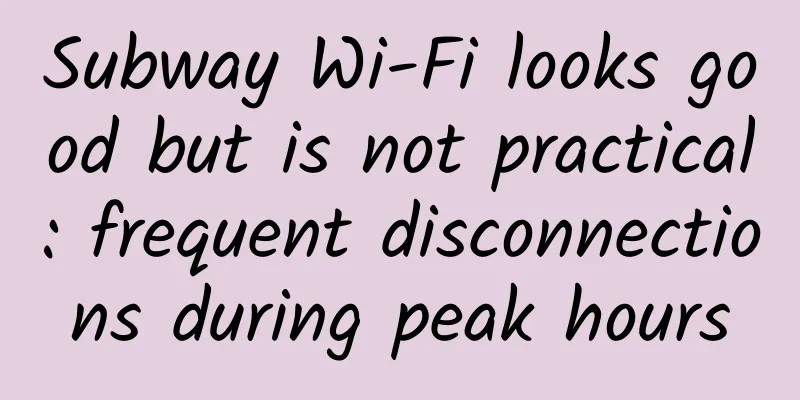Subway Wi-Fi looks good but is not practical: frequent disconnections during peak hours

|
More than half a month ago, Shenzhen Metro Group and Southern Silver Valley Company jointly announced that Shenzhen Metro was the first in the country to achieve free Wi-Fi coverage throughout the entire metro. This Wi-Fi, improved by metamaterial technology, is said to be 20 times faster than 4G networks, and even has no problem watching high-definition videos. However, during the trial operation of the project, many citizens complained that the Shenzhen Metro Wi-Fi often failed to connect or was frequently disconnected, especially when the trains were running. Why did such a popular convenience measure fall into such an embarrassing situation as soon as it was launched? The reporter recently conducted an investigation into this. Wi-Fi Experience Comparison On the first day of opening on July 30, the reporter measured the network download speed in the Huaqiangbei station hall and platform and found that the average speed was 4.52Mbps. The speed of opening web pages and watching videos was fast. Although the network was disconnected occasionally, it was generally good. Recently, the reporter visited the station again and found that the average Wi-Fi speed in the station hall and platform has dropped to 3.7Mb/s. Unlike the experience half a month ago, the number of network disconnections has increased. In the 5-minute test period, the network was disconnected 3 times. Current situation: The network condition in the station hall needs to be improved, and the situation is even worse when the train is running. On July 30 this year, Shenzhen Metro Line 1 and Line 2 took the lead in launching full-line Wi-Fi services for free use by citizens. The so-called full-line Wi-Fi means that Wi-Fi signals not only cover the subway station halls and platforms, but also the fast-moving trains. Once this technology is realized, it means that passengers can access the Internet for free on the subway, while avoiding the possible interference to train operations caused by bringing their own wireless routers. "In cities like Hong Kong, citizens can use free Wi-Fi in station halls and platforms, but they cannot use it after getting on the train. Shenzhen Metro has solved this problem very well." At the press conference for the opening of the trial operation, Zhou Fazhan, head of the project's investor and builder, Southern Silver Valley Company, said that the Shenzhen Metro Wi-Fi technology is not only a domestic first, but also has no precedent in the world. How is the trial effect of a world-leading technological innovation? The reporter found that in the more than half a month since the trial operation of free Wi-Fi in Shenzhen Metro, many citizens have frequently reported that the subway Wi-Fi often has unstable signal connection, especially during rush hours in the morning and evening. Sometimes the signal is full but it cannot be connected, and the login verification code (peanut code) has also been suspended. In order to compare the signal strength changes of subway Wi-Fi at the beginning of opening and at present, the reporter conducted field tests at Huaqiang North Station on Line 2 several times. On the first day of opening on July 30, the reporter measured the network download speed in the concourse and platform of Huaqiang North Station and found that the average speed of network download in the area was 4.52Mbps, and the speed of opening web pages and watching videos was fast. Although the network was disconnected occasionally, it was generally used well. Recently, the reporter visited the station again and found that the average Wi-Fi speed in the station hall and platform has dropped to 3.7Mb/s. Unlike the experience half a month ago, the number of network disconnections has increased, with a total of 3 disconnections during the 5-minute test period. In addition, the network speed and network connection conditions in different areas of the subway station hall are also different. Some locations have strong signals, while others have weak signals. Tests on moving trains show that the network connection of subway Wi-Fi is worse than that of station halls and platforms. In the past, although the network speed was average when using Wi-Fi on trains, network disconnection was rare, and opening web pages or even watching videos was basically no problem. But now, it is necessary to connect repeatedly, and it may not be able to connect to the Internet. Sometimes, even if you can barely connect to the Internet, network disconnection occurs frequently. Response: Exceeding the limit for a single device will limit other users’ access Shenzhen News Network previously launched a survey on the use of subway Wi-Fi, collecting a total of 452 statistical data. The results showed that when using subway Wi-Fi, 46.49% of people reported that they "could not obtain the verification code"; secondly, 44.68% of netizens reported that the network "could not be connected". There were also other problems such as unsuccessful registration, poor signal, slow network speed, etc., which were also reported frequently. In response to the unstable signal and poor connection reported by citizens, the reporter interviewed Ms. Tan, the spokesperson of Southern Silver Valley Company, which is responsible for the investment, construction and operation of Shenzhen Metro Wi-Fi. She said that since it is the first time to introduce Wi-Fi in the subway, as a new technical solution for subway wireless coverage, there is no ready-made system and solution to refer to, and problems need to be discovered during the trial operation, and continuous adjustment and optimization are needed. "There is no technical problem, but in order to ensure the safe operation of the subway, the signals of trains 1 and 6 are still set to be relatively weak." Ms. Tan said that through the trial operation data and problem feedback, carriages 1 and 6, as the front and rear of the train, have become the places where users have the largest amount of Internet access. In the future, we will complete the signal optimization plan for trains 1 and 6 as soon as possible without affecting the train signal." At the same time, regarding the situation that citizens are concerned about when the signal in the station hall is full but they cannot access the network, Ms. Tan explained: "The subway crowd follows the law of tidal travel. The station hall has a large flow of people during peak hours in the morning and evening, and the density of people in a certain area is too high. In order to ensure the experience of connected users, a single device will limit the connection of other users after a certain number of connected users have reached. "Therefore, at stations with extremely large passenger flow such as Che Kung Temple and Ping Chau, users reported that they could not find the signal during peak hours. In fact, the access points were already fully loaded and the signal was automatically blocked. Next, we will take targeted measures to increase coverage in stations with dense populations." Ms. Tan said that during this period, Southern Silver Valley is conducting comprehensive monitoring and analysis of the operation of the Wi-Fi system and actively looking for solutions. "In addition to fully improving the entire network system, we will also adjust the rules for issuing Peanut Codes based on citizens' feedback to give citizens a good sense of participation." Ms. Tan told reporters that our network is free for citizens to use. Due to the large number of subway passengers, we can only ensure that Peanut Society members can have a good network experience, but we cannot promise that every subway passenger can connect to the network." Extension: Subway Wi-Fi is more difficult to implement than bus Wi-Fi What kind of technology does Southern Silver Valley use? Why can't it ensure that every passenger can use the Internet smoothly? The reporter learned that there are indeed certain technical difficulties in deploying Wi-Fi systems on subways. As early as November 2012, Shenzhen Metro Line 2 and Line 5 had repeatedly been interrupted by the interference of portable Wi-Fi wireless routers used by passengers, resulting in train interruptions (for details, see this newspaper report on November 26, 2012). The system developed by Southern Silver Valley Company mainly overcomes the problems of signal interference and large concurrency of millions of people online at the same time during peak hours. Its key technology comes from the metamaterial technology of the Guangqi Research Institute. Liu Ruopeng, founder of the Guangqi Institute of Advanced Science and Technology, once simply explained that "metamaterials mainly control the direction of electromagnetic waves to isolate the signals emitted by Wi-Fi hotspots and prevent them from interfering with the train system." In addition to the high security requirements, by comparing with buses, we can also understand other special features of subway Wi-Fi. It is reported that many buses in Shenzhen are now covered with free Wi-Fi. For example, a system developed by Juyang Media has been covered on multiple buses such as M224, 326, 369, 303, and 385. VisionChina Media has also reached a cooperation with Huawei and will provide Wi-Fi services on multiple buses in Shenzhen in the future. The reporter found that the Wi-Fi on the bus is much more stable than the Wi-Fi on the subway, and network interruptions rarely occur. "The Wi-Fi on the bus is different from the Wi-Fi on the subway because the base stations of the mobile companies are all built on the ground and the buses also run on the ground, so the signal switching is smoother. In addition, the passenger flow on the subway is much denser than that on the bus, so the signal is not as stable as on the bus," said Wang Yang, head of Juyang Media. In addition, the subway scene is more complicated than the bus. According to the person in charge of Southern Silver Valley, the Wi-Fi transmitting equipment on the train is different from that on the platform and in the station hall. In theory, when passengers with Android phones enter from one scene to another, they need to manually switch the network. In order to simplify the procedures, the developer integrated the two networks through the background, and only one APP software is needed to ensure that customers can connect once. "However, to ensure that all users can connect continuously across scenarios, it is necessary to conduct personalized analysis of all models on the market. This workload is huge and is still in progress. Therefore, some users are prone to network interruptions when switching between carriages and platforms." The person in charge of the appeal said. In addition, since the subway Wi-Fi routers are placed in the "iron box" of each carriage, when the device is blocked by the crowded crowd, the signal is likely to be weaker. sound Shenzhen Metro Company: Wi-Fi project outsourcing undergoes strict review process What do the subway operation and management departments think about the current problems with Shenzhen Metro Wi-Fi? Wang Yuzhu, spokesperson for Shenzhen Metro Group, told reporters that because the technology has the characteristics of being tried first, they are still tolerant of this innovative pilot. But at the same time, they will urge Southern Silver Valley to conduct a full investigation of related issues and improve the network system in a timely manner. According to the reporter, Shenzhen Metro is happy to see the construction of Wi-Fi. Long before the Shenzhen Metro was forced to stop by Wi-Fi, the subway company had already started the construction of the Wi-Fi system. "First, to meet the requirements of Shenzhen's construction of a wireless city, so that citizens can have more complete and thoughtful supporting services when traveling; at the same time, to prevent passengers from improperly using Wi-Fi devices, causing the normal operation of the train to be affected." Shenzhen Metro related personnel introduced. In addition, the subway company is keen on building Wi-Fi systems for economic reasons. According to Wang Yuzhu, the profitability of Shenzhen Metro has been worrying since its network operation, and it has relied on government subsidies. In order to balance the public welfare of the subway and the profitability of the company, Shenzhen Metro has been exploring appropriate channels to increase revenue other than ticket sales. Outsourcing the operation of subway Wi-Fi is one of the ways. On March 13, 2012, Shenzhen Metro released an announcement on its official website about the construction of the Shenzhen Metro Wi-Fi system. The announcement stated: "Our company (the metro company) intends to carry out the construction of the Shenzhen Metro Wi-Fi system. We sincerely invite qualified and interested contractors to participate. Interested parties please reply to our company in writing before 5:00 p.m. on March 16, 2012." The Metro Group has put forward five requirements to the contractor. First, the contractor agrees to invest in the construction and operation and maintenance of the subway wireless Internet system, but the system cannot install any equipment in the subway tunnel; second, the subway wireless Internet system built cannot cause any interference to the subway operation system; third, agree to pay fees to the subway company; fourth, it must establish the main page of the Shenzhen Metro service logo free of charge, and access and publish subway information free of charge; fifth, the system must be permanently free for subway passengers. According to the subway, after the announcement, a company was indeed interested in taking over the business. After comprehensively comparing the company's strength and technical reliability, they chose Southern Silver Valley Company to invest in and operate the Shenzhen Metro Wi-Fi system. There is not much public information about the company. The reporter learned from relevant channels that Shenzhen Guangqi Research Institute is one of the company's investors and has also provided technical support to the company. The current investment in the project may have reached 70 to 80 million yuan. Reporter's Notes: Subway Wi-Fi technology innovation will take some time According to the reporter's understanding, in recent years, many cities in China have "tested the waters" of providing free Wi-Fi in public places, but problems such as difficulty in logging in, poor signals and slow network speeds have generally emerged. In some places, the service even disappeared after a period of implementation. Since the construction of public Wi-Fi is very expensive, if it relies solely on government investment, it will put huge pressure on local finances. However, as Shenzhen Metro has done, opening public spaces to qualified companies through legal procedures to build and operate public Wi-Fi is a sustainable business model. For enterprises, by building free Wi-Fi in public places and taking the lead in seizing traffic entrances, they can gradually accumulate a certain scale of users. Under appropriate conditions, enterprises can achieve win-win results by inserting commercial advertisements and conducting e-commerce business, while safeguarding the public interest. The reporter found that in Shenzhen, whether it is bus Wi-Fi or subway Wi-Fi, almost all of them are operated in this market-oriented way. Companies also strictly abide by the code of conduct of "not spending taxpayers' money and not charging users", although not many companies have been able to find an effective profit model. As the first subway Wi-Fi project in China, Southern Silver Valley's technological innovation may need some time to be tested. As the company's head repeatedly said: "This innovative technology has no precedent before, and problems are inevitable during the trial operation stage. I hope to gain the understanding and support of the public." However, this kind of innovation also has certain "opportunity costs" and must be based on the possession and consumption of existing public resources (such as subway space resources). If companies cannot solve some of the problems existing in the current Wi-Fi operation process as soon as possible, it may also be a harm to the public interest. As a winner of Toutiao's Qingyun Plan and Baijiahao's Bai+ Plan, the 2019 Baidu Digital Author of the Year, the Baijiahao's Most Popular Author in the Technology Field, the 2019 Sogou Technology and Culture Author, and the 2021 Baijiahao Quarterly Influential Creator, he has won many awards, including the 2013 Sohu Best Industry Media Person, the 2015 China New Media Entrepreneurship Competition Beijing Third Place, the 2015 Guangmang Experience Award, the 2015 China New Media Entrepreneurship Competition Finals Third Place, and the 2018 Baidu Dynamic Annual Powerful Celebrity. |
<<: Beats Music app enters the list of "Apple-developed apps"
>>: The three most noteworthy changes in MIUI 6
Recommend
How to use user habits for precision marketing?
User habits can provide powerful strategies for p...
Foshan WeChat used car mini program function, how much does it cost to develop a used car transaction mini program?
With the rise of "new energy" vehicles, ...
Why do "singing gods" always appear in bathrooms? | Science Museum
Bathing is important to everyone. It’s something ...
A guide to avoiding pitfalls in overseas marketing
How popular are brands going overseas? According ...
Best Practices for Selecting Software Composition Analysis Tools
Software composition analysis (SCA) tools were cr...
Analysis of mobile Internet monetization methods: application distribution (Part 1)
For all developers or companies working on mobile...
Pinduoduo’s user growth skills!
1 The number of active buyers on Pinduoduo reache...
It’s called a ship, but where are the wheels of the ship?
Why do we always call ships "ships"? Do...
How can China's TV industry, which is caught in a state of internal involution, save itself and others?
Users are walking away from their TVs with disdai...
collect! 8 ways to get social media traffic!
Whether it is Internet e-commerce or traditional ...
The latest news on the epidemic in Wuxi, Jiangsu in 2022: What is the risk level? Attached is the latest prevention and control policy!
According to the current epidemic situation, Wuxi...
"One bite makes your neck stretch two miles!" This kind of yogurt has become very popular recently, but two types of people should be careful when eating it!
Recently, there has been a trend of "dry yog...
Baidu releases a car robot with L5 autonomous driving capabilities, which is officially claimed to be safer than human driving
On August 18, Baidu held its 15th "Baidu Wor...
Research reveals: The pain in those "Internet Depression Cloud" moments is real
Slowly close your eyes and imagine the following ...
August's hot topics! I just ask you whether you want to chase her or not!
Chasing hot topics has become one of the essentia...









